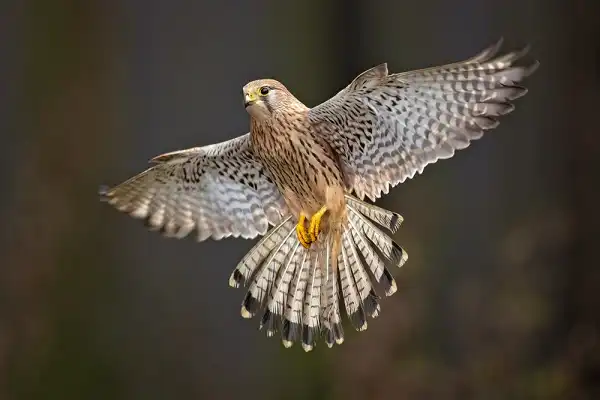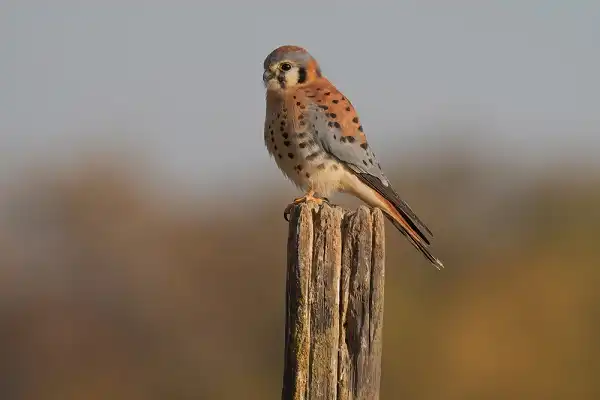Do you want to understand more about the kestrel, one of nature’s finest flyers? The Kestrel is a small bird of prey that can be found throughout much of the world and is known for its sharp vision and cutting-edge aerodynamics. This comprehensive blog post will provide you with all the facts you need to know about these cunning predators as well as a few tips on how to successfully spot them in their habitats. So buckle up your feathered seatbelt for an educational exploration into the amazing, agile world of Kestrel!

Kestrel Description
The Kestrel is a member of the falcon family that is found throughout much of the world, particularly in Europe, Asia, and North America. It has adapted to a wide range of habitats from tundra to deserts. Kestrels are small birds of prey with sharp eyesight and small pointed wings that make them incredibly agile in flight, allowing them to hover or even fly backward. They have long tails which are used for balance while they swoop and soar in pursuit of their prey. In addition to their excellent flying ability, kestrels also have keen senses of hearing and smell making them adept hunters. Kestrels come in many different colors ranging from light blue-gray to reddish brown with black-and-white barring on the wings and tail feathers. Their heads are usually white or pale buff colored with bands along the sides and back. Male kestrels are often more brightly colored than females.
Kestrel Habitat
Kestrels are known to be found in a variety of habitats ranging from tundra to deserts, though they tend to prefer open areas such as meadows and grasslands. They can also be spotted near wooded edges and more sparsely wooded areas. Kestrels are sometimes observed in urban settings, often perched on rooftops or power lines. The kestrel’s nesting habits vary depending on the region; some will build their nests while others may adopt abandoned nests of other birds or even use old stick-filled cavities in trees. The nest is usually constructed out of sticks lined with softer materials such as moss and lichen. Kestrels will generally form monogamous pairs that remain together year-round, staying close by during the breeding season and often hunting together when food is scarce. The female typically lays between 4 and 5 eggs that she incubates for around 30 days before they hatch. Both parents feed the young until they become independent after about three weeks.
Kestrel Diet
Kestrels feed mainly on small mammals such as mice, voles, birds, reptiles, insects, and even invertebrates like earthworms. To survive cold winters in northern habitats, some kestrel populations migrate south while others remain near their breeding grounds by adapting their diet to include more small rodents which require less energy expenditure when hunting. They hunt by perching on high spots like fence posts or tree branches where they can survey the area for potential prey before swooping down to catch it midair or grabbing it from the ground. Kestrels prefer live food but will also eat dead animals if needed. They often store spare food in caches near their nests and may hold onto large scraps of meat to consume them at a later date. While they usually hunt alone, they sometimes team up with other predators such as hawks or owls during times of plenty to take advantage of larger prey that can’t be captured on their own.

Kestrel Size
Kestrels are relatively small raptors, typically measuring between 30-35cm in body length and weighing only around 125g. Their wingspan also tends to measure between 50-60cm. They have short, pointed wings and a long tail that helps them navigate with agility when hunting. Kestrels come in many different color morphs depending on their region of origin. These birds have an array of adaptations that enable them to survive in their varied habitats; for example, their dark eye spots help to startle potential predators while their mottled plumage provides excellent camouflage against both aerial and ground threats. In addition, they possess powerful talons used for capturing prey and are known to be fiercely territorial during the breeding season.
Kestrel Lifespan
Kestrels have a relatively short lifespan in the wild, with most individuals living between five and seven years. In captivity, however, they can live up to 15 years or more. The oldest recorded kestrel was a remarkable 22 years old when it died in the Netherlands in 2018. Though their average life expectancy is shorter than many other birds of prey, kestrels make up for this by having a much higher reproductive rate than other raptors. After mating, kestrel pairs will typically lay one clutch of eggs per year and sometimes even two if food is readily available. This allows them to increase their population quickly even if individual lifespans are relatively short. Life expectancy for female kestrels tends to be slightly lower than for males due to the additional energy expenditure associated with laying eggs and incubating them. Additionally, young kestrels are more vulnerable to predation from larger birds or mammals as well as adverse weather conditions that could lead to starvation or exposure. Despite these risks, some adult females have been recorded reaching up to 11 years of age in the wild.
Kestrel Behavior
Kestrels are incredibly social creatures and can often be found hunting in large groups or flocks. During the breeding season, they are fiercely territorial and will vigorously defend their nests from other birds of prey as well as potential predators. They typically form strong monogamous bonds with a single mate that can last for many years, sometimes even a lifetime. Kestrels use a variety of techniques to hunt and capture their prey, such as hovering in mid-air to scan the ground below or perching on elevated spots to keep an eye out for possible meals. If they spot something of interest, they will quickly swoop down to snatch it from the ground or snatch it out of the air with their talons. Kestrels communicate with one another through a variety of vocalizations such as chirps and trills. Additionally, they have a wide range of body language they use to indicate aggression or submission during mating rituals or territorial disputes. In addition to vocal calls, kestrels will also click their bills rapidly when threatened – this is thought to either startle potential predators or warn other nearby kestrels of danger.

Kestrel Speed
Kestrels are incredibly speedy birds, capable of reaching speeds of up to 60 mph while in flight. They are also highly maneuverable and can make sharp turns and sudden stops to quickly catch their prey. Additionally, they can stall in mid-air and hover for several seconds at a time to spot potential meals below. Kestrels prefer open areas such as grasslands and fields where they can easily survey the area for food. Once they’ve spotted something of interest, they swoop down on it with remarkable speed and agility. They are also able to use the wind currents to their advantage, gliding along without flapping their wings when necessary to gain altitude without expending too much energy. Kestrels have been recorded flying over 10 miles in one hour during active migration periods, making them some of the longest-distance flyers among all species of birds. Their energy efficiency allows them to fly great distances with very little rest or refreshment needed along the way. Kestrels also engage in dynamic soaring by using thermal updrafts created by the sun’s heating of the ground during midday hours to gain more height without having to flap their wings much at all.
Kestrel Hunting
Kestrels are highly skilled hunters, relying on both speed and agility to capture their prey. While hunting in the air, they will use a variety of techniques such as hovering mid-air to scan the ground below, or soaring high above the landscape and using air currents to gain height without having to expend too much energy. They also make sudden dives at potential prey while in flight, using their sharp talons to snatch it out of the sky. Kestrels also show remarkable precision when hunting on the ground. Using their keen eyesight and acute hearing, they can detect small animals such as rodents running through tall grasses or hiding among rocks and debris.
Once spotted, they will execute quick turns and dart toward their target with remarkable speed and accuracy. They may also stand still for long periods to wait for prey to come within striking distance before quickly snatching it up into their talons. Kestrels will also hunt cooperatively in groups when necessary. This can include performing group dives or aerial chases where several birds will swoop down simultaneously on an unsuspecting animal below. Additionally, they may work together while perched on elevated spots such as tree branches or telephone wires to keep an eye out for potential meals below that could be taken by one of the group members.

Conclusion
Kestrels are remarkable birds that can soar at high speeds and make sharp turns in mid-air. They use various techniques such as dynamic soaring, cooperative hunting, and hovering scans to capture prey with remarkable accuracy. With their speed, agility, and keen senses, kestrels are some of nature’s most efficient hunters! By taking a closer look at the behavior of these magnificent raptors, we can gain a greater appreciation for the incredible adaptive capabilities these birds possess. Kestrels continue to provide an awe-inspiring example of how animals can use their natural talents to survive – and even thrive – in the wild!
Frequently Asked Question

